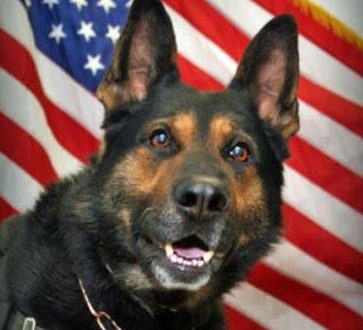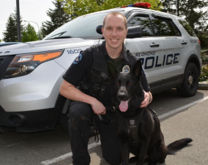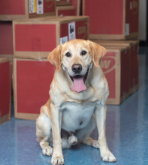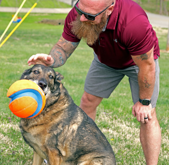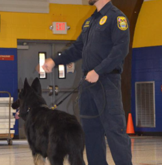Died 1/19/16
Handler – Deputy Scott Gukich
Sheriff’s K9 Officer Mink laid to rest
One of Jefferson County’s most popular law enforcement officers has been laid to rest. Mink, a German Shepherd and one of the Jefferson County Sheriff’s Office’s three K-9 officers, was put to sleep Tuesday, Jan. 19, after an attempt to surgically address a bladder tumor failed to improve his quality of life. “His unconditional love for his job and partner could be easily satisfied by a simple throw and a tug of toy or a wolfing down of a doggie treat from one of the dispatchers,” Jefferson County Sheriff’s Office Chief Deputy Jeff Parker said of Mink. “His commitment to protection, awesome tracking capabilities and taking drugs off our streets were done with a servant’s heart and a wagging tail.” Capt. Paul Wallace noted that Mink and his handler, Deputy Scott Gukich, made an excellent team and the department will miss Mink as part of the family. Mink had served with Gukich for seven years and had been due for retirement later this year. “We did have plans to purchase another dog,” Wallace said, noting that funding for a new K-9 dog was included in the 2016 budget. Ideally, the K-9 officers remain in service for approximately seven to eight years. “They are such high-drive animals,” Wallace said. “They are not like regular house dogs. These guys have little idiosyncrasies about them that make them have the ability to do what they do.” The captain said that after eight years of service, the department likes to allow the dogs to have a more normal couple to three years of life. “They start to slow down and start to lose their drive and then we bring a new dog into the program,” Wallace said. Mink had developed a tumor on his bladder, and a surgical procedure was completed to relieve the pressure on his bladder and his back. However, Wallace said, the tumor just was too massive to allow Mink to retain normal bodily functions. “For his quality of life, we made the decision that he needed to be laid to rest,” the captain said. Mink’s end of watch was Tuesday, Jan. 19. Deputy Gukich has not said directly as to whether he intends to remain as a handler. Having just lost Mink, he will take a couple of weeks to consider it, Wallace said. “I would be surprised if he didn’t take another dog,” Wallace said, noting that Gukich loves the interaction with the dogs, as do all the sheriff’s office personnel involved with the K-9 units. Around May, a group of Jefferson County Sheriff’s Office staff will travel to Shallow Creek Kennels in Sharpsville, Penn., to select a new dog from a number of quality K-9 candidates. Shallow Creek staff then will begin training the dog in drug detection, tracking, area searches, building searches, evidence searches, apprehension and handler protection. The handlers will decide, based on the dog’s individual temperament, whether residing indoors with the deputy’s family will be a detriment to the dog’s training. However, Capt. Wallace said most of the department’s dogs have been good family dogs. He said the handler then will participate in a two-week course to train with the new dog at the Pennsylvania kennel. “If people could see all the things these dogs can do, they would be amazed,” the captain said. Jefferson County’s K-9 program began in 1991 with then-Detective Sgt. Paul Milbrath and his labrador retriever, Redman. Milbrath was elected Jefferson County sheriff in 2002. Redman served until 1999, but the department did not have a formal K-9 unit until then-Sgt. Parker submitted a proposal to begin the program in 1998. Jahn, a German Shepherd, was the first K-9 deputy to serve under that program, along with his handler, Deputy Greg Jansen. Since then, the office consistently has had three K-9 deputies at a time. With Mink’s passing, the department is served by Harlow and handler Deputy Jason Behm and Falkos and handler Deputy Jansen. Besides Redman, Jahn and Deuce, past dogs that have served with the department include German Shepherds Ahron and Jasko. The sheriff’s office also had a bloodhound, Ellie Mae, who now is retired. Other than Ellie Mae, all of the K-9 officers have been dual-purpose dogs performing duties ranging from drug detection, tracking, area searches, building searches, evidence searches and apprehension to handler protection. “If you lose your car keys or something, we could send the dog out and he would be able to locate your keys because the odor coming from the keys is not a normal odor,” the captain said. As further example, he said that if a suspect throws a gun out the window of a car and there is some general idea of where that occurred, the dogs will be used to search for the weapon. Three weeks ago, Wallace said, Mink was involved in such a search. Although no gun was recovered, Mink found the magazine cartridge for the weapon, allowing investigators to determine it was a pellet gun. “During the life of an average K-9, I don’t even know how to describe how many times over the dog pays for itself through the confiscation and detection of controlled substances while it’s out on the streets working,” said Wallace.
